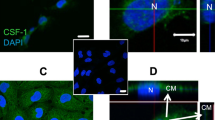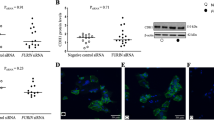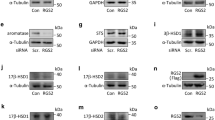Abstract
SOME human tumours and tumour-derived cell lines are capable of producing ‘eutopic’ peptide hormones and other proteins that are normally synthesised by the tissue from which the tumour originated. For example, choriocarcinoma cells, which are derived from cancer of the placental trophoblast, can synthesise human chorionic gonadotrophin (hCG) (refs 1, 2), and cultured pituitary adenomas can produce growth hormone (GH) (ref. 3). On the other hand, it is well established that a variety of malignant human tumours can produce ‘ectopic’ peptide hormones and other proteins which are not normally associated with the tissue of origin4–8. Ectopic synthesis of placental proteins, including the placental isoenzyme of alkaline phosphatase as well as the hormones hCG and human placental lactogen, may provide specific markers for neoplasm, since these proteins are not normally found in measurable amounts in the serum of men or of non-pregnant women9. Several human glycoprotein trophic hormones, including hCG, thyroid-stimulating hormone (TSH), luteinising hormone (LH), and follicle-stimulating hormone (FSH), are composed of two non-identical subunits, α and β (refs 10–13). These four hormones have virtually identical α subunits; in contrast each has a unique β subunit, which is responsible for biological specificity12. Complete hCG and free subunits are secreted by normal and neoplastic placenta1,2,14 and by many non-trophoblastic tumours15,16. Since hCG is a eutopic hormone for trophoblastic tumours, but an ectopic hormone for non-trophoblastic tumours, it occured to us that its synthesis by the two types of tumours might be regulated differently. We therefore compared the synthesis of hCG and hCG-α by three choriocarcinoma cell lines—BeWo (ref. 1), JEG-3 (ref. 2) and Reid (P. O. Kohler, unpublished observations)—with the synthesis by two non-trophoblastic tumour-derived cell lines—ChaGo and HeLa. (ChaGo was derived from an hCG-producing pulmonary carcinoma16, and HeLa from a carcinoma of the cervix17.) We also tested the effects of sodium butyrate on the synthesis, since this compound had been shown to induce hCG-α and hCG synthesis in certain HeLa cells18. We found that in the absence of inducer, all of the cell lines can produce hCG-α—the trophoblastic tumour cells at roughly comparable rate, but the non-trophoblastic tumour cells at widely different rates (Fig. 1).
This is a preview of subscription content, access via your institution
Access options
Subscribe to this journal
Receive 51 print issues and online access
$199.00 per year
only $3.90 per issue
Buy this article
- Purchase on Springer Link
- Instant access to full article PDF
Prices may be subject to local taxes which are calculated during checkout
Similar content being viewed by others
References
Pattillo, R. A. & Gey, G. O., Cancer Res. 28, 1321–1236 (1968).
Kohler, P. O. & Bridson, W. E. J. clin. Endocrin. Metab. 32, 683–687 (1971).
Kohler, P. O., Bridson, W. E., Rayford, P. L. & Kohler, S. E. Metabolism 18, 782–788 (1969).
Bower, B. F. & Gordan, G. S. A. Rev. Med. 16, 83–118 (1965).
Liddle, G. W., Nicholson, W. E., Island, D. P., Orth, D. N., Abe, K. & Lowder, S. C. Rec. Progr. Horm. Res. 25, 283–314 (1969).
Rees, L. H. & Ratcliffe, J. G. Clin. Endocrin. 3, 263–299 (1974).
Orth, D. N. Nature new Biol. 242, 26–28 (1973).
Rabson, A. S., Rosen, S. W., Tashjian, A. H., Jr & Weintraub, B. D. J. natn. Cancer Inst. 50, 669–674 (1973).
Rosen, S. W., Weintraub, B. D., Vaitukaitis, J. L., Sussman, H. H., Hershman, J. M. & Muggia, F. M. A. Intern. Med. 82, 71–83 (1975).
Swaminathan, N. & Bahl, O. P. Biochem. biophys. Res. Commun. 40, 422–427 (1970).
Morgan, F. J. & Canfield, R. E. Endocrinology 88, 1045–1053 (1971).
Pierce, J. G. Endocrinology 89, 1331–1344 (1971).
Saxena, B. B. & Rathnam, P. J. biol. Chem. 246, 3549–3554 (1971).
Franchimont, P., Gaspard, U., Reuter, A. & Heyner, G. Clin. Endocrin. 1, 315–336 (1972).
Rosen, S. W. & Weintraub, B. D. New Engl. J. Med. 290, 1441–1447 (1974).
Tashjian, A. H., Jr, Weintraub, B. D., Barowsky, N. J., Rabson, A. S. & Rosen, S. W. Proc. natn. Acad. Sci. U.S.A. 70, 1419–1422 (1973).
Gey, G. O., Coffman, W. D. & Kubieck, M. T. Cancer Res. 12, 264–265 (1952).
Lieblich, J. M., Weintraub, B. D., Rosen, S. W., Ghosh, N. K. & Cox, R. P. Nature 265, 746 (1977).
Lowry, O. H., Rosebrough, N. J., Farr, A. L. & Randall, R. J. J. biol. Chem. 193, 265–275 (1951).
Edlow, J. B., Ota, T., Relacion, J., Kohler, P. O. & Robinson, J. C. Am. J. Obstet. Gynec. 121, 674–681 (1975).
Author information
Authors and Affiliations
Rights and permissions
About this article
Cite this article
CHOU, J., ROBINSON, J. & WANG, SS. Effects of sodium butyrate on synthesis of human chorionic gonadotrophin in trophoblastic and non-trophoblastic tumours. Nature 268, 543–544 (1977). https://doi.org/10.1038/268543a0
Received:
Accepted:
Issue Date:
DOI: https://doi.org/10.1038/268543a0
Comments
By submitting a comment you agree to abide by our Terms and Community Guidelines. If you find something abusive or that does not comply with our terms or guidelines please flag it as inappropriate.



